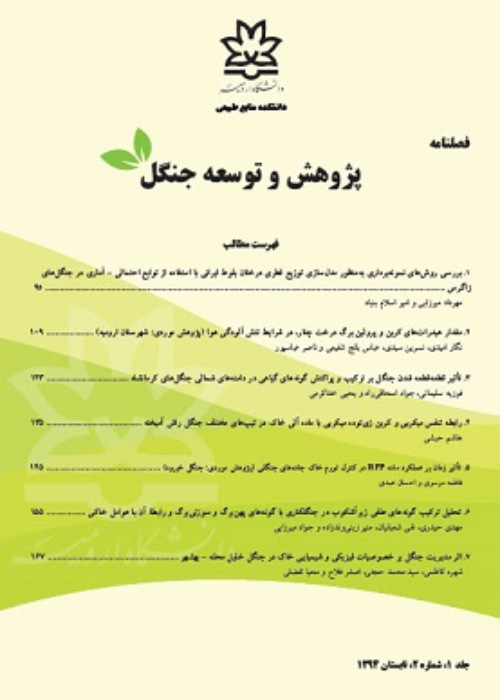Modeling fine woody debris volume stock using logistic analyses in the Hyrcanian Kheiroudkenar research forest
Due to ecological and biological importance of fine woody debris (FWDs) in forest ecosystems, it is essential to be clarified influencing factors on the FWDs volume stock through appropriate model. One of the models can be decisively efficient for optimal management and control of the FWDs volume stock is the ordinal logistic model. It is expected that the FWDs have a significant contribution in the Hyrcanian forests where different types of plant communities and trees are widely distributed across altitude gradients. Thus, the aim of this research is to use rank logistic analysis to examine the impact of various factors on the volume accumulation of the FWDs in relation to the altitude gradient of the Khairudkanar research forest.
The current study was conducted in the Kheiroud forest using the cluster sample plots implemented along the altitude (100- 1800 m). A total of 12 samples were arranged in an altitude gradient from sea level. These samples consisted of three circular plots, each with a radius of 7.32 meters. The circular plots were positioned in the form of a triangle, with azimuth angles of 0, 120, and 240 degrees. Additionally, another sample with the same area was placed at the center of this design. The distance between each of the circular plots in the cluster was 36.6 meters. In this study, the placement of sample plots was conducted randomly within the specified altitude range, with an interval of 150 meters. A total of 36 clusters were established, comprising 144 samples, within the research forest. These samples were categorized into three diameter classes for the FWDs: 1-2.5 cm, 2.5-4.5 cm, and 4.5-7.5 cm. To measure the diameter of these small dry trees, a linear transect was executed from the center of each circular sample plot. The transect had a fixed azimuth of 150 degrees. Specifically: The diameter layer within the range of 1-2.5 cm was measured at a distance of 4.27-1.6 meters, and For other diameter layers, the measurements were taken at distances ranging from 7.32 to 7 meters. Ultimately, a total of 4.27 meters were harvested during this investigation. During the evaluation process, a transect line was used to measure the FWDs diameter whose central axis was obstructed by the line. Additionally, the type of species, the decay or lack of decay of the FWDs were also recorded. However, the length of these FWDs was not measured in the field due to the evaluation method used. In the analysis, we employed Spearman’s test and calculated Spearman’s correlation coefficient. Additionally, we utilized Chi-square statistics and the dimensions of the consensus table to evaluate the significance of correlation intensity between variables. To model this relationship, we included all uncorrelated variables as input variables, irrespective of any co-linear relationships among the factor variables. Nominal and rank variables were introduced as factors with fixed effects, while quantitative variables served as side variables during the implementation of rank logistic analysis. To validate each model, we assessed various variables using the model fit index. Additionally, we considered the pseudo-explanation coefficients. The significance of the model and its calculation coefficients was examined using the Wald statistic. Furthermore, we evaluated the model’s accuracy in relation to estimated values and observations using Pearson and standard deviation tests.
The research findings indicated that the average volume of the FWDs per hectare in the studied forest was 2.14, 6.01, and 16.23 cubic meters for the first, second, and third diameter classes, respectively. The results of logistic analyses based on the log-likelihood test (X2= 0.06; P > 0.05) and pseudo-R2 (Pesudo-R2 = 0.001) showed that the altitude gradient has no significant effect on the volume accumulations of the FWDs in different diameter classes. According to the Cramer's V and Spearman correlation tests, the results demonstrated that altitude gradient significantly correlated with the stand types, aspect, species and decay of the FWDs in the study forest. Moreover, the results obtained using Kramer's correlation coefficient to eliminate the effects of collinearity between input variables indicated that there is no significant relationship between the aspects and the species, and decay classes. Also, there were no significant correlations between the stand type and decay, and the FWDs species. Taking into account the non-collinearity and variance inflation factor (VIF), the final results of modeling showed that the FWDs species and decay have only significant effects on variations of the first diameter class of FWDs volume stock (Pesudo-R2= 0.24; P < 0.05; X2= 22.61).
On the basis of the Wald test, effects of the FWDs species were similarly significant, and the FWDs decay was inversely significant in association with the FWDs first diameter class response (P < 0.01). It appears that the amount of volume accumulation of the FWDs in thicker diameters was not affected by the factors that were introduced. This implies that many unforeseen events, such as natural disturbances of varying scales and intensity, as well as the inherent nature of forestry - including developmental stages - may be the foremost factors that significantly impact the volume inventory of the FWDs in the thicker diameters.
- حق عضویت دریافتی صرف حمایت از نشریات عضو و نگهداری، تکمیل و توسعه مگیران میشود.
- پرداخت حق اشتراک و دانلود مقالات اجازه بازنشر آن در سایر رسانههای چاپی و دیجیتال را به کاربر نمیدهد.


